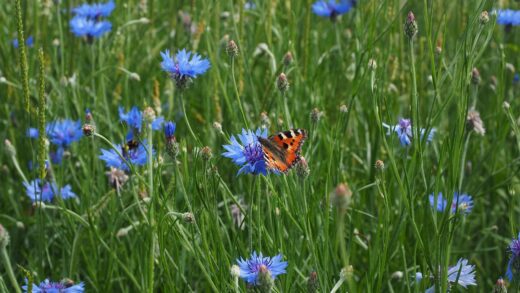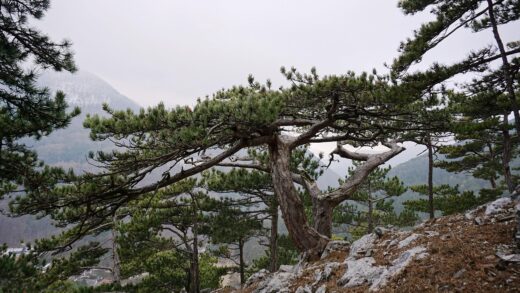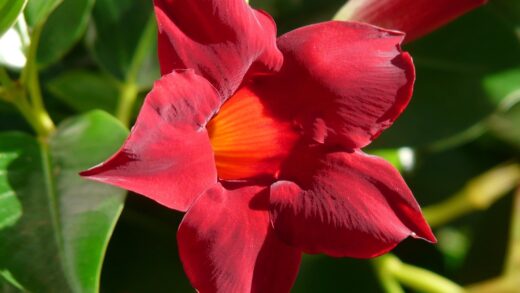Despite its reputation as a tough and resilient shrub, cherry laurel is not immune to problems and can be afflicted by a range of diseases and pests. These issues can detract from the plant’s ornamental value, causing unsightly damage to the foliage, and in severe cases, they can compromise the overall health and longevity of the plant. Understanding the most common threats is the first step toward effective management. A proactive approach that emphasizes prevention through good cultural practices—such as proper planting, watering, and pruning—is always more effective than reacting to an established infestation or infection.
Many of the most common diseases that affect cherry laurel are fungal or bacterial in nature and are often exacerbated by environmental conditions. High humidity, poor air circulation, and foliage that remains wet for extended periods create a perfect breeding ground for these pathogens. Diseases like shot hole and powdery mildew are prime examples of problems that thrive in such conditions. Therefore, preventative measures like spacing plants correctly to allow for airflow and using drip irrigation instead of overhead sprinklers can significantly reduce the incidence of these diseases.
Pests can also pose a threat, ranging from leaf-chewing insects to sap-sucking culprits. Insects like vine weevils can cause characteristic notching on the leaves, while their grubs can inflict more serious damage by feeding on the roots below ground. Scale insects and aphids feed on the plant’s sap, which can weaken the shrub and lead to sooty mold growth. Early detection is key to managing pest populations before they become large and difficult to control. Regular inspection of the leaves, stems, and soil around the plant is a vital part of an integrated pest management strategy.
Ultimately, the best defense against both diseases and pests is a healthy, vigorous plant. A cherry laurel that is growing in its preferred conditions and is not stressed by drought, waterlogging, or nutrient deficiencies will be naturally more resistant to attack. When problems do arise, it is important to accurately identify the cause in order to select the most appropriate and effective control method, favoring cultural and biological controls before resorting to chemical treatments.
Common fungal diseases
Shot hole disease is perhaps the most prevalent issue affecting cherry laurels. This condition is characterized by the appearance of small, circular purple or brown spots on the leaves. As the disease progresses, the center of these spots dries up and falls out, leaving behind a series of holes that give the leaf a “shot-gun” appearance. While it can be caused by bacteria, it is most often the result of a fungal pathogen, Wilsonomyces carpophilus. The disease is most active during cool, wet spring weather. While it looks alarming, shot hole disease is primarily a cosmetic issue and rarely causes serious harm to an established plant.
More articles on this topic
To manage shot hole disease, the focus should be on cultural practices that reduce moisture on the foliage. Pruning to thin out dense growth will improve air circulation, allowing the leaves to dry more quickly after rain or dew. It is also crucial to avoid overhead irrigation, which wets the leaves directly. Instead, use a soaker hose or drip irrigation to apply water directly to the soil at the base of the plant. Raking up and destroying fallen, infected leaves in the autumn can also help to reduce the amount of fungal spores that can overwinter and cause new infections the following spring. In cases of severe, persistent infection, a fungicide containing copper can be applied just as the leaves emerge.
Powdery mildew is another common fungal disease that can affect cherry laurel, especially those growing in shady, humid, or crowded conditions. It appears as a white or grayish powdery coating on the surface of the leaves, young stems, and flower buds. The fungus siphons nutrients from the plant, and in heavy infestations, it can cause leaves to yellow, distort, or drop prematurely. While it can be unsightly, like shot hole, it is not typically a life-threatening disease for the shrub.
Prevention of powdery mildew again hinges on improving air circulation and reducing humidity around the plant. Ensure there is adequate spacing between plants and prune to open up the canopy. Choosing a planting site with good morning sun can also help, as the sunlight will burn off dew from the leaves early in the day. There are numerous horticultural oils and fungicides available for treating powdery mildew, including sulfur-based products and potassium bicarbonate solutions. These are most effective when applied at the very first sign of the disease.
Bacterial diseases and prevention
Bacterial leaf spot and shot hole can also affect cherry laurel, presenting symptoms that are very similar to their fungal counterparts. Bacterial infections often thrive in the same cool, wet conditions that favor fungal pathogens. The bacteria typically enter the plant tissue through natural openings or wounds, such as those caused by pruning or insect damage. The resulting spots on the leaves may appear water-soaked or have a yellowish halo around them before the center falls out. Differentiating between bacterial and fungal shot hole without a laboratory analysis can be difficult, but fortunately, the management strategies are largely the same.
More articles on this topic
The primary line of defense against bacterial diseases is prevention, as there are fewer effective chemical treatments available compared to fungal diseases. The most critical preventative measure is to avoid working with the plants when their foliage is wet. Pruning or handling wet leaves can easily spread the bacteria from one part of the plant to another, or from an infected plant to a healthy one. Always wait until the foliage is completely dry before undertaking any pruning or maintenance tasks.
Proper sanitation of tools is also paramount in preventing the spread of bacterial diseases. Pruning shears, loppers, and hedge trimmers should be regularly sterilized, especially after cutting away any diseased-looking tissue. A simple and effective sterilizing solution can be made by mixing one part household bleach with nine parts water, or by using a 70% isopropyl alcohol solution. Dipping or wiping the blades between cuts on a single plant, and certainly between moving from one plant to another, can stop the transmission of microscopic pathogens.
As with fungal diseases, cultural practices that promote quick drying of foliage are key. Improving air circulation through selective pruning, providing adequate spacing between plants, and using ground-level irrigation are all effective strategies. A healthy plant is also better able to compartmentalize and resist the spread of an infection. By ensuring your cherry laurel is not stressed by poor soil, improper watering, or nutrient deficiencies, you are building its natural defenses against a host of potential bacterial problems.
Identifying common insect pests
The vine weevil (Otiorhynchus sulcatus) is one of the most significant pests of cherry laurel. The damage is caused by both the adult weevils and their larvae, but the larvae are far more destructive. Adult weevils are dull black, flightless beetles that feed on the leaves at night, creating characteristic C-shaped notches along the leaf margins. While this damage is unsightly, it is the larvae, or grubs, that pose the real threat. These small, white, C-shaped grubs live in the soil and feed on the roots of the plant. A heavy infestation can girdle the main stem at the soil line, killing the plant.
Scale insects are another common pest. These are small, sap-sucking insects that attach themselves to the stems and the undersides of leaves, often appearing as small, raised, shell-like bumps. They feed on the plant’s sap, which can weaken the cherry laurel over time, leading to yellowing leaves and reduced vigor. As they feed, scale insects excrete a sticky substance called honeydew, which coats the leaves below. This honeydew is often colonized by a black, non-pathogenic fungus called sooty mold, which, while not directly harming the plant, can block sunlight and reduce photosynthesis.
Aphids are small, soft-bodied insects that also feed on plant sap, typically congregating in clusters on new, tender growth and the undersides of leaves. Their feeding can cause the new leaves to become distorted, curled, or stunted. Like scale insects, aphids also excrete honeydew, leading to the same issues with sooty mold. While a small aphid population is unlikely to cause major harm to a large, established cherry laurel, a heavy infestation can weaken the plant and transmit plant viruses.
Other less common pests might include spider mites, which are tiny arachnids that can cause a stippled or bronzed appearance on leaves, particularly in hot, dry conditions. You might also find caterpillars of various moth species feeding on the foliage. The key to management is regular inspection. By frequently checking the leaves (including the undersides) and stems of your plants, you can catch these pest problems early, when their populations are small and much easier to control through simple measures like hand-picking or a strong jet of water from a hose.
Integrated pest management (IPM) strategies
Integrated Pest Management (IPM) is a sustainable, common-sense approach to controlling pests and diseases that prioritizes the least toxic methods first. The foundation of any good IPM program is prevention and cultural control. This involves creating a garden environment that is less hospitable to pests and diseases from the outset. For cherry laurel, this means selecting a proper planting site with good drainage and air circulation, improving the soil with organic matter, and maintaining plant health through appropriate watering and fertilization. A healthy plant is the best defense.
Biological control is another key component of IPM. This involves encouraging and protecting the natural enemies of pests that are already present in your garden. Ladybugs, lacewings, and hoverflies are voracious predators of aphids. Predatory ground beetles can help control vine weevil populations. You can attract these beneficial insects by planting a diversity of flowering plants, avoiding the use of broad-spectrum pesticides that kill beneficials along with pests, and providing a source of water. This creates a balanced ecosystem where pest populations are often kept in check naturally.
When pest populations exceed an acceptable threshold and intervention is necessary, IPM favors mechanical or physical controls first. This can be as simple as hand-picking larger pests like adult vine weevils off the plants at night with a flashlight. A strong spray of water from a hose can be very effective at dislodging aphids and spider mites from the foliage. Using sticky traps can help monitor and reduce populations of flying insects. These methods are non-toxic and target the pest directly with minimal impact on the surrounding environment.
The final step in an IPM program is the responsible use of chemical controls, often referred to as pesticides or fungicides. If chemical intervention is deemed necessary, the least toxic options, such as horticultural oils or insecticidal soaps, should be chosen first. These products work by smothering soft-bodied insects like aphids and scale and have a low impact on beneficial insects and wildlife. Stronger, synthetic pesticides should be used only as a last resort, targeted specifically at the pest, and applied strictly according to the label directions to minimize harm to non-target organisms and the environment.
Environmental stress and non-infectious disorders
Not all problems that affect cherry laurel are caused by living organisms. Many common issues are the result of environmental stress or cultural practices, often referred to as abiotic or non-infectious disorders. One of the most common is winter burn or sun scorch. This occurs when the evergreen leaves lose water through transpiration from sun and wind during the winter, but the frozen ground prevents the roots from absorbing more water to replace it. This results in the leaves turning brown, yellow, or bronze, particularly on the side of the plant exposed to prevailing winds or winter sun.
Soil-related issues are another major source of stress. As previously mentioned, poorly drained or waterlogged soil is one of the biggest threats to cherry laurel, leading to root rot and the death of the plant. On the other end of the spectrum, soil that is too dry can cause drought stress, leading to wilting, leaf drop, and a weakened plant that is more susceptible to secondary pest infestations. Soil compaction can also be a problem, restricting root growth and reducing the availability of both water and oxygen in the soil.
Nutrient imbalances, as discussed in the context of fertilization, are another form of environmental stress. An improper soil pH can make essential nutrients like iron unavailable, leading to chlorosis. Both a lack of necessary nutrients and an excess of them from over-fertilization can cause significant harm. Applying too much fertilizer can lead to a buildup of salts in the soil, which can “burn” the roots and damage the plant. Physical damage from lawnmowers, string trimmers, or construction activities can also create wounds that stress the plant and provide entry points for disease.
The key to diagnosing these non-infectious disorders is to look for patterns and consider the recent environmental conditions and care practices. Is the damage uniform across the entire plant, or is it localized to one side? Have there been extremes in temperature or rainfall? Was a chemical applied nearby? Often, the solution to these problems lies not in spraying a chemical but in correcting the underlying cultural or environmental issue, for example by improving soil drainage, providing a windbreak, or adjusting watering practices.


















